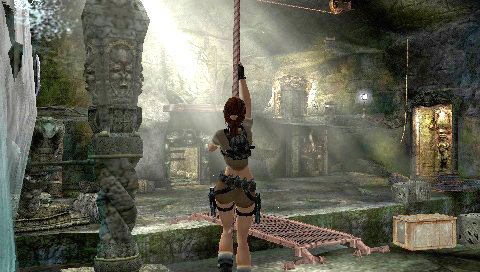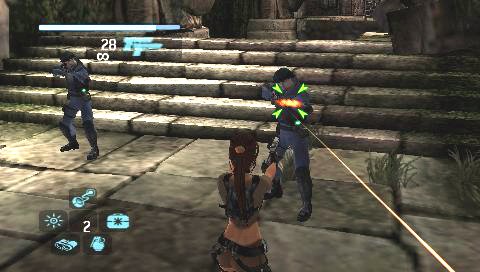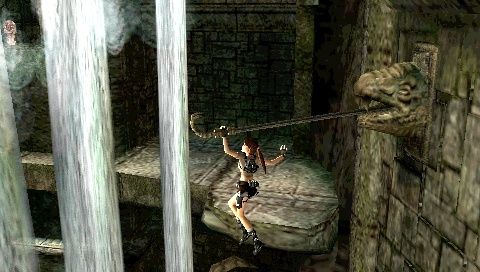Lara Croft made a triumphant return in early 2006 with the release of Tomb Raider: Legend for home consoles and the PC. But that's not enough for Lady Croft, as now she's making her debut on the PlayStation Portable. The game is essentially the same on the PSP as it was on the consoles, so if you've played it before then you can expect to visit the same levels and solve the same puzzles all over again. Unfortunately, the biggest difference between the PSP version and the others is also its biggest downfall, and that is the often cumbersome, imprecise, and downright frustrating control. But if you can learn to live with the control, you'll find that Tomb Raider: Legend is a mostly competent action adventure with more than a few enjoyable and exciting moments.

Tomb Raider: Legend follows Lara Croft as she tries to piece together the fragmented memories and knowledge of her past. Before the end of the story you'll learn about Lara's mother, an estranged friend and colleague turned nemesis, and even King Arthur. The story doesn't make a lot of sense, and it definitely isn't confined to realistic or even believable events. For the most part though, the story is just an excuse to travel all over the world in search of mystical artifacts and the answers to the questions about Lara's past.
The eight levels in the game take you to exotic locations on four different continents. You'll explore ruins in Bolivia, search an abandoned research facility in Kazakhstan, perform death-defying acrobatics high above the streets of Tokyo, race a motorcycle on a dusty stretch of Peru, and more. The levels are all fairly expansive and varied enough to keep things interesting. They also look great, and the visuals haven't been significantly diminished in the translation to the handheld. You'll see some clipping and collision-detection issues as Lara interacts with objects in the environment, but for the most part the game looks great. That is, until you actually try to move around. The frame rate in Tomb Raider: Legend is usually sluggish, but when there's a lot of action happening onscreen the game slows down significantly. Fortunately most of the game is dedicated to exploration, which isn't as taxing on the frame rate as some of the more lively action sequences.
Most of the levels in the game involve the same basic objectives. You move through a level from start to finish, solving puzzles to unlock doors, jumping between platforms to reach out-of-the-way places, and indiscriminately murdering any man or beast that you come into contact with. The platforming and puzzle-solving is the best part of the game. The puzzles aren't difficult, and if you've played the other versions of the game you'll be able to breeze right through this one. Lara has a handy magnetic grapple this time around that lets her grab distant objects, tow large items around to be used to weigh down switches and such, and swing across chasms like Pitfall Harry. She also has an impressive repertoire of slick moves. Lara can leap from one narrow cliff ledge to another, hanging on by only her fingers, swing on ropes or conveniently placed bars, and get up to all of the usual Tomb Raider fare. It can be exciting and rewarding to expertly navigate a tricky platforming section or solve a puzzle, and there are plenty of those moments to experience throughout the game.
Lara knows her way around a firearm too, be it her twin pistols, a grenade launcher, or a mounted chaingun. The gunplay is by far the weakest part of the game though, because it just isn't exciting or challenging in any way. You simply hold the L button to lock onto a target, and then hop around like a kangaroo while blasting away at your foe. You can do some fancy slow-motion moves like jumping off of an enemy's head and shooting him as you fly through the air, but those moves don't make the gunplay any more satisfying. There are also a couple of motorcycle levels that play out like a rail shooter. You have to ride along, shooting at waves of enemies and jumping over gaps. These sections aren't nearly as exciting as they sound, and they drag on for way too long.

The human foes and occasional leopard are nothing to worry about, but the camera can often become your greatest enemy. It's a constant struggle to get a clear view of the next platform or ledge you need to jump to. The problem is magnified on the PSP, because there's no second analog stick with which to adjust the camera. That means that if you want to tweak the camera angle you have to stop what you're doing, hold the square button, and then use the analog stick to position the camera where you want it. That works fine until you start moving and the camera decides to show you a nice close-up of Lara's face or a wall. In the many platforming sections of the game, you'll quickly settle into an awkward pattern of lining up the camera, making a jump, and then pausing to realign the camera before making the next jump. You can attempt blind jumps, but that will almost always result in instant death for Lara and much hair-pulling and fevered cursing from you as you wait 20 seconds or more for the game to load so you can go fall off a cliff again.
The camera isn't your only nemesis in the game though, as you'll also often find yourself fighting with the imprecise control afforded by the single analog stick on the PlayStation Portable. It's difficult enough just to run in a straight line using the analog stick, but attempting some of the precarious platforming in Tomb Raider: Legend can be exceedingly awkward. There are several areas in the game that require you to line up in just the right direction in order to make a jump, but this is next to impossible when Lara can't change direction in anything less than 45-degree increments.
Aside from the sometimes aggravating analog control, the button layout isn't exactly conducive to quick, intuitive actions. Instead of switching guns, tossing grenades, or using your grapple on the fly, you have to use the directional pad to cycle through a menu, select the item or action you want, and then press the triangle button to use it. Fortunately you can usually just leave your grapple equipped and forget about all your other equipment. Most of it isn't necessary or useful anyway.
Multiplayer minigames are exclusive to the PSP version of Tomb Raider: Legend, and they can be played via an ad hoc connection. Two players can go head-to-head in a handful of different games that take place on levels from the single-player game. There's a game where you have to race from the beginning of a level to the end; one where you have to hide an artifact and then go look for your opponent's hidden artifact; and one where you have to activate three beacons scattered throughout the level. These minigames aren't especially fun, mostly because they suffer from the same control and camera issues as the single-player game. It's an interesting novelty to see two Lara Crofts running around, but it won't keep your interest for more than a few minutes.

The sound in Legend hasn't been sacrificed in translation to the PlayStation Portable. Lara and the other characters are all interesting and full of personality, thanks to some great voice acting. Lara in particular has just the right amount of cheesy action-hero lines to maintain the light tone of the game without making it seem overly silly. The music is also excellent, and provides a perfect backdrop for a grandiose, globe-trotting adventure.
If you've played the console versions of Tomb Raider: Legend you'll be able to breeze through the PSP version in a few hours, since all the puzzles and levels are all the same. The only new challenge to be found in this version is the challenge of adapting to the uncooperative camera and clunky controls. Even if you haven't played the game before, you can beat it in six hours, which is short for a console game (although it seems slightly more excusable on a handheld). That said, Legend is still a decent game with plenty of satisfying puzzles and expansive levels that look great and can be fun to explore. If you're looking for a straightforward action adventure and don't mind making some sacrifices for the sake of portability, Tomb Raider: Legend fits the bill.